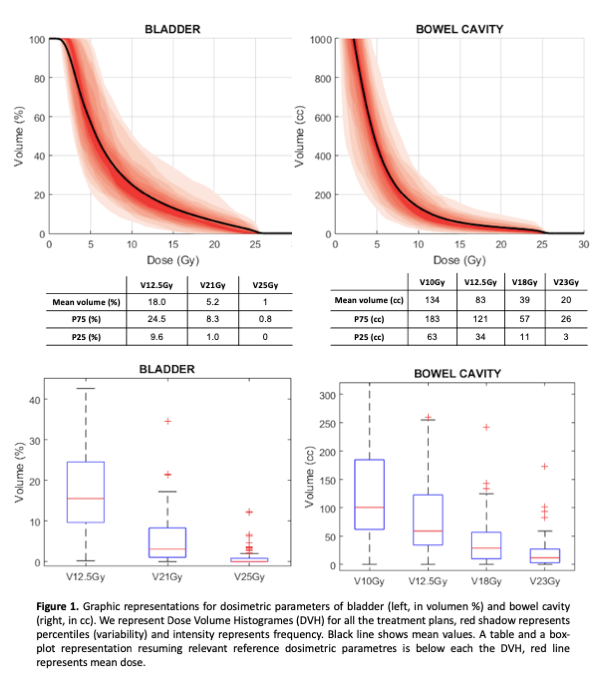Organs at Risk dose analysis for rectal cancer short-course radiotherapy
PO-2007
Abstract
Organs at Risk dose analysis for rectal cancer short-course radiotherapy
Authors: Francesc Sansaloni1, Enar Recalde2, Begoña Navalpotro2
1Vall d'Hebron Hospital, Medical Physics, Barcelona, Spain; 2Vall d'Hebron Hospital, Radiation Oncology Department, Barcelona, Spain
Show Affiliations
Hide Affiliations
Purpose or Objective
Total neoadjuvant therapy (TNT) is a novel approach to locally advanced rectal cancer (LARC) that has increased the number of patients treated with short course radiotherapy (SCRT). There is lack of clinical evidence and literature on OARs constraints for SCRT, where constraints are calculated from LCRT using linear quadratic model and also optimizing the dose to OARs.
We aimed to review the dosimetric data that OARs received in patients treated whit SCRT in our institution and try to develop in house dose optimization objectives.
Material and Methods
Data from SCRT plans of 82 LARC patients treated from February 2018 to March 2022 were retrospectively collected. All of them were treated with Varian Halcyon 2.0 linac with 6FFF MV and VMAT technique.
In house software was used to analyse the dose-volume histograms (DVH) Different dosimetric parameters were studied for the most representative OARs: bowel cavity, bladder and femoral heads. Patient characteristics and structure volumes were also studied. Results were compared with published data (1-2).
Results
Patient mean age decreased from 77 years in 2018 to 68 years in 2022. Treated PTV mean volume was 941 cc (range p25 795 cc – p75 1063 cc). Mean volume was 169 cc (range p25 87 cc – p75 210 cc) and 1472 cc (range p25 1937cc – p75 3476 cc) for bladder and bowel cavity, respectively.
Figure 1 shows DVH statistics and boxplots of selected dosimetric parameters for bladder (V12.5y, V21Gy and V25Gy) and bowel cavity (V10Gy, V12.5Gy, V18Gy and V23Gy).
As can be seen in the Figure 1, the mean V21Gy value for bladder was 5.2% and did not present great variability between different plans, meanwhile the mean V12.5Gy was 18% and presented greater variability between plans. The mean V18Gy value in bowel cavity was 39cc and did not present great variability, while the mean V12.5Gy was 83cc and presented greater variability between plans. For the femoral heads, volume at 50% of prescribing dose was analyzed; V12.5Gy was 11.4%, with an interquatile range from 4.6% to 16.4%.

Conclusion
The DVHs of OARs do not show large variation, indicating robust plan optimization. Also, the variability observed could be attributed to the anatomical variability between patients.
The results show values much lower than the SCRT in house constraint presented at UK protocol (1). Comparing with Appelt et al. (2), ours mean values and interquartile ranges for bladder and bowel cavity are similar to reported data, and slightly higher for femoral heads.
References
(1) The Royal College of Radiologists. National rectal cancer intensity-modulated radiotherapy (IMRT) guidance. London: The Royal College of Radiologists, 2021. Ref No. BFCO(21)1
(2) Appelt AL, Kerkhof EM, Nyvang L, et al. Robust dose planning objectives for mesorectal radiotherapy of early stage rectal cancer - A multicentre dose planning study. Tech Innov Patient Support Radiat Oncol. 2019;11:14-21. Published 2019 Oct 15.